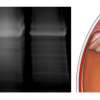Proteomics is the culmination of advances in chemistry, physics, bioinformatics, and molecular biology that allow the study of thousands of proteins simultaneously. A proteome can be defined as the complete set of proteins expressed in a particular cell or tissue of interest. This strategy is especially important in eye diseases where there are limited cell and animal models.
We are using proteomics to discover biomarkers, therapeutic targets, and molecular pathways involved in several eye diseases where diagnosis is difficult and current treatment is inadequate.









